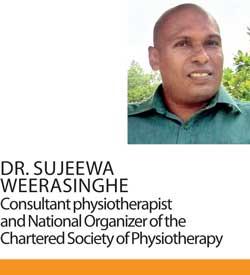21 Aug 2020 - {{hitsCtrl.values.hits}}

 Sleep is a basic human need and is essential for sound health, quality of life and performing well during the day. Several indicators can be used to describe sleep disturbance or sleep disorders. The main effects of sleep deprivation include physical effects (sleepiness, fatigue, and hypertension) cognitive impairment (deterioration of performance, attention and motivation; diminishment of mental concentration and intellectual capacity and increase of the likelihood of accidents at work and during driving) and mental health complications. Inadequate rest impairs the ability to think, to handle stress, to maintain a healthy immune system and to moderate emotions. Total sleep deprivation is fatal with regard to some animal species. To bring you tips on how to obtain sound sleep we obtained the help of Dr. Sujeewa Weerasinghe who is a Consultant physiotherapist and National Organiser of the Chartered Society of Physiotherapy.
Sleep is a basic human need and is essential for sound health, quality of life and performing well during the day. Several indicators can be used to describe sleep disturbance or sleep disorders. The main effects of sleep deprivation include physical effects (sleepiness, fatigue, and hypertension) cognitive impairment (deterioration of performance, attention and motivation; diminishment of mental concentration and intellectual capacity and increase of the likelihood of accidents at work and during driving) and mental health complications. Inadequate rest impairs the ability to think, to handle stress, to maintain a healthy immune system and to moderate emotions. Total sleep deprivation is fatal with regard to some animal species. To bring you tips on how to obtain sound sleep we obtained the help of Dr. Sujeewa Weerasinghe who is a Consultant physiotherapist and National Organiser of the Chartered Society of Physiotherapy.
Unable to sleep
A sleep disorder is a condition where a person is tired but unable to sleep. This results in a lack of sleep quality and not getting enough hours of sleep each night. It also affects the time of night when a person starts to feel tired, plus their overall health and life quality. There are many different types of sleep disorders, all with their own symptoms, causes and treatments. Some of these include parasomnia, sleep apnea, insomnia, narcolepsy etc.
Breathing Exercises
If someone learns to do deep breathing exercises it helps to shift the mind away from worry thoughts. Taking slow deep breaths also sends signals to the brain that you are calm, which in turn can slow down your heart rate and nervous activity. When breathing correctly the idea is to focus on allowing your diaphragm to drop when you inhale so your lungs can fully expand. By breathing out you allow the diaphragm to rise as you exhale, which will in turn compress the lungs and push the air out as you exhale.
Nasal breathing
Breathing through the nose is physiologically more relaxing for the body. Your nasal cavity is especially designed to warm and filter air you inhale. The mouth does not have the same structures. Breathing through the nose allows your body to process the air more efficiently, which will slow down the activity of your heart and nervous system.
The technique
Inhale through your nose and allow the belly to move outward. As the abdomen moves out, room is created for the diaphragm to drop. Then exhale through the nose and let the belly move inward so the diaphragm presses up. If you are dealing with sinus or respiratory issues, try breathing in through the nose and exhaling through pursed lips.
Focusing attention
To help slow down the mind to encourage sleep, keep your attention on the movement of the breath. Make each breathe a little slower and a little deeper. With each exhale, allow your body to feel heavy and sink into the bed.

Relaxation
In the face of sleep disorders, relaxation techniques are the key to a good night’s sleep. Sleep relaxation techniques decrease the wear and tear on the mind and body and reduce stress symptoms. In general, relaxation techniques involve refocusing the attention to something calming and increasing awareness of the body.
Types of Relaxation Techniques
Autogenic relaxation: In this relaxation technique, both imagery and body awareness is used to reduce stress. Repeat words or suggestions in mind to relax and reduce muscle tension. Imagine a peaceful place and then focus on controlled, relaxing breathing, slowing the heart rate, or feeling different physical sensations, such as relaxing each arm or leg one by one.
Progressive muscle relaxation: Start by tensing and relaxing the muscles in the toes and progressively work up to the neck and head. Tense the muscles for at least 5 seconds, then relax for 30 seconds, and repeat. Focus on slowly tensing and then relaxing each muscle group, becoming more aware of physical sensations. It doesn’t necessarily matter which relaxation technique one choose, as long as you practice relaxation regularly to reap benefits. These techniques are skills, and the ability to relax improves with practice. Don’t let the effort to practice these techniques become yet another stressor.
Sleep, as a physiological state, is necessary for the wellbeing of the living organism. Its interactions with daytime activities are profound and they determine the global equilibrium between these two fundamental states: sleep and wakefulness. Sleep normality and sleep quality concepts are used in the everyday life, although it is often difficult to state clearly how to define them. Sleep structure is changing over time and this progressive evolution is quite variable from one individual to another. The sleep quality concept may also considerably vary from one person to another as subjective expectancy is highly variable and complex.
21 Dec 2024 6 hours ago
21 Dec 2024 7 hours ago
21 Dec 2024 21 Dec 2024
21 Dec 2024 21 Dec 2024
21 Dec 2024 21 Dec 2024